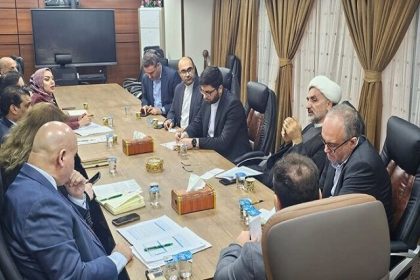Isna/Isfahan The creation of an alloy with unique characteristics of strength and malleability by the researchers of Tehran University promises a new evolution in advanced industries and engineering materials.
The researchers of Technical Faculty of Tehran University have achieved significant success in the field of designing and manufacturing new alloys at the world level. By creating a high entropy alloy system, they succeeded in producing an alloy with unique mechanical properties that has the ability to combine strength and ductility at the same time. These combined properties distinguish the manufactured alloy from other existing alloys and make it an ideal material for use in various industries. High entropy alloys, due to the combination of several different elements, have the possibility of achieving a more stable structure and better properties than traditional alloys. In this research, with the help of the creative combination of elements and the use of advanced methods, researchers have been able to develop a high entropy alloy that has both high resistance to pressure and tension and high formability. This success will not only improve industrial processes, but also reduce costs and increase the quality of final products. The achievement of Iranian scientists in this field has provided a suitable opportunity to develop new technologies and strengthen the industry at the national and international level, and will have wide applications in the aerospace, automotive and medical industries in particular.
In this regard, we have had a conversation with Mohammad Javad Sohrabi, a materials engineering researcher at the Laboratory of Advanced Steels and Thermomechanical Processes of Engineering Materials of the University of Tehran.
What special mechanical properties have been developed in this new alloy and why are these properties unique?
The alloy developed by the researchers of the University of Tehran exhibits remarkable mechanical properties at ambient temperature, including significant yield strength and ultimate tensile strength along with very good ductility. In the discussion of material development, increasing strength usually causes a decrease in ductility. However, the alloy developed in this research simultaneously shows very good strength and ductility, which is superior compared to many materials developed so far.
What is a high entropy alloy and how can it have the properties of strength and ductility at the same time?
High entropy alloys (HEA) are a group of alloys that are composed of a combination of several elements with close ratios to each other, and this particular combination introduces a different approach from traditional alloying. This innovative structure has paved the way for the design of alloys with unique properties and provides many opportunities for materials science engineers. Due to their complex and diverse structure, high entropy alloys have found wide applications in the aerospace, automotive and energy industries and can improve the performance of materials in difficult conditions. Research in the field of high entropy alloys is progressing rapidly and attention to this field is increasing day by day in various industries. Since increasing strength in materials usually comes at the cost of reducing ductility, balancing these two valuable properties is a fundamental challenge in the development of new alloys, but a deeper understanding of strengthening mechanisms and how to engineer these mechanisms can make it possible to achieve high strength. and provide flexibility at the same time. In simpler words, by knowing the mechanisms in these alloys and their targeted engineering, it is possible to optimally benefit from the mechanical properties and obtain alloys with both strength and ductility; Alloys that can show superior performance in challenging environments and achieve a special place in advanced industries.
What innovations or new methods have been used in the manufacturing process of this alloy that differentiates it from other existing alloys?
In the alloy developed by the researchers of Tehran University, by engineering and optimizing the strengthening mechanism of martensitic transformation and coupling it with the strengthening mechanisms of microgranulation and solid solution strengthening; Significant mechanical properties have been obtained. The main innovation of this alloy is the engineering of the mechanical stability of the austenite phase, which allows combining several strengthening mechanisms simultaneously in this alloy. In this regard, the chemical composition and microstructure of the alloy have been optimized and carefully controlled.
In what applications can this new alloy be useful and which industries will benefit the most from it? The developed alloy has very impressive mechanical properties that are well preserved not only at ambient temperature, but also at very low temperatures and cryogenic conditions. These outstanding features have made this alloy an ideal choice for use in industries such as automotive, shipbuilding, and aircraft; Industries in which achieving excellent mechanical properties and resistance is of great importance. As a reliable and efficient material, this alloy can play a key role in improving the performance and strength of structures in these industrial fields.
How did they achieve this achievement and what stages or tests have been done in the research and development of this alloy?
In the way of obtaining this high entropy alloy, first the previous researches were carefully and comprehensively investigated and a comprehensive understanding of various strengthening mechanisms was obtained. After that, by performing thermodynamic simulations, the appropriate chemical composition was designed for the development of this alloy. In the next step, various alloys were produced and subjected to the casting process to finally achieve the optimal and desired alloy that is currently under investigation. Therefore, to achieve this chemical composition and this special alloy, important steps were taken; The first stage includes in-depth and comprehensive studies in this field, then thermodynamic simulations to find the optimal chemical composition, and then manufacturing and testing different alloys until the final alloy is selected. In the end, by applying appropriate thermomechanical treatment, the microstructure of the alloy was carefully controlled and optimized to provide remarkable mechanical properties.
Is this new alloy able to be produced on an industrial scale and what challenges might there be in its mass production?
The possibility of producing this alloy on an industrial scale is completely ready and Tehran University, due to the success in producing laboratory samples, has the necessary capacity to increase the scale of production and achieve industrial production. The only issue raised in this process is the cost of its production; Although this cost is relatively reasonable and slightly higher than austenitic stainless steels, this increase is mainly due to the presence of the cobalt element in the composition. However, considering the wide applications and outstanding performance of this alloy in various industries, its production cost is justified compared to the functional benefits and high mechanical resistance, and it can create significant added value for industries.
What advantages do high entropy alloys have over traditional alloys and how can they help improve the quality of industrial products?
In the concept of high entropy alloys, we are facing a new perspective that is fundamentally different from traditional and common alloys. In conventional alloys, one main element is used as a base and other elements are added as alloying elements, but in high entropy alloys, several elements are combined in approximately equal proportions at the same time to create a unique alloy. This variety in the selection and combination of alloy elements provides the possibility of unlimited design and development of different alloy systems and gives material engineers and alloy designers unparalleled freedom in creating materials with the desired properties. Each alloy element can have a different effect on mechanical properties, corrosion resistance and functional properties, and by fine-tuning the chemical composition, optimization of various properties can be achieved in different alloys. The introduction of these types of alloys in recent years has attracted the attention of many researchers and materials engineers and has found wide applications in the industry. In summary, the concept of high entropy alloys has dramatically increased the possibility of designing and developing new and innovative alloys. Now, based on various industrial needs, we can combine various combinations of elements in such a way as to create alloys with desirable and appropriate properties that are heavily used in various industries and have opened new horizons for materials science.
Have you optimized or commercialized this alloy and what are the future plans to develop and use this alloy?
In terms of optimization and commercialization of this alloy, it should be said that the currently developed alloy has been chosen as an optimal option among several investigated alloys. However, it is still possible to further improve its mechanical properties through slight changes in the chemical composition, applying thermomechanical operations and precise control of its microstructure. In the next steps, we intend to strengthen and improve the mechanical properties of this alloy by taking advantage of these changes. In terms of commercialization, there is currently no concrete plan underway, but our current goal is to focus on further optimization to address the diverse properties of this alloy for various applications. So far, the tensile properties of this alloy have been investigated at ambient temperature, but there are many capacities in testing its properties at cryogenic temperatures and different deformation conditions such as shearing, compression and other deformation modes, which can expand its applications in Different industries lead.
This research is in the form of a doctoral dissertation by Mohammad Javad Sohrabi, a student at the University of Tehran, under the guidance of Hamed Mirzadeh Sultanpour and the advice of Reza Mahmoudi, professors of the Faculty of Metallurgy and Materials Engineering, University of Tehran, and Saeed Sadeghpour from the University of Oulu, Finland, in the “Laboratory of Advanced Steels and Thermomechanical Processes of Engineering Materials” » Technical Colleges of Tehran University has been carried out and has resulted in significant achievements.
Numerous articles resulting from this research have been published in various publications and have been welcomed by the global scientific community and are sometimes recognized as a reference for future research. In the preparation of these articles, Mahmoud Nili Ahmadabadi and Mohammad Habibi Parsa, professors of the Faculty of Metallurgical and Materials Engineering, University of Tehran, Sajjad Mehranpour, Alireza Kalhor, and Ali Heidarinia, graduates of the Faculty of Metallurgical and Materials Engineering of Tehran University, and researchers from Silesian Technical University of Poland and the University Pohang Science and Technology of South Korea cooperated.
Correspondent: Maryam Turkzad
end of message
RCO NEWS

















